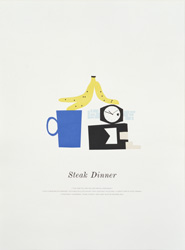Matthew Brannon, Steak Dinner, 2007.
Born 1971 in Saint Maries, Idaho; lives in New York, New York
Matthew Brannon’s work turns on the opposition—and ever-mounting imbrication—of art and design. After an early stint as a painter, he began to draw his inspiration from those printed materials that mediate everyday life in late-capitalist, early twentyfirst- century America, from posters and advertisements to promotional flyers and take-out menus. But if Brannon’s iconography conjures mass-produced, throwaway sources, his methods are laboriously handcrafted, even old-fashioned: screenprint, letterpress, and lithograph works, often executed in a limited palette and consistent in their graphic rigor. His art seems on first glance disarmingly direct. But as one turns to the text paired with his images for explication or illumination, disorder intervenes. An early series recalls the conventions of posters for horror films: in Sick Decisions (2004), the driveway leading to a stately house is cloaked by shadows cast by bare, looming trees. In place of what look to be credits in the lower part of the work, however, is a string of pithy non sequiturs: this film is “A Desperate Appeal Release,” starring, among others, “Abuse of Education” and “Misplaced Trust,” with a screenplay by “101 Unanswered Phone Calls.”
In recent work Brannon pictures signifiers of contemporary metropolitan life ranging from the quotidian (an alarm clock, a tube of toothpaste, a banana peel) to the more rarefied (oysters, sushi, champagne). Here again, the straightforward quality of each depiction is oΩset by bewildering, quasi-poetic phrases running below it, what the artist has called a “salad of language.” One line of text under the silhouette of a lobster reads, “this is how it ends” (The Price of Admission, 2007); another, below the rendering of a showerhead and bar of soap, “And when he’s home at night trying to sleep/ He sees himself as a gross pig that everyone hates” (Alarm Clock, 2007). Behind the veneer of convenience, plenty, and success implied by the content and format of his images, Brannon seems to suggest, reside darker imperatives—abuse, excess, careerism, insecurity, and failure.
Previous installations of Brannon’s work have suggested environments such as a corporate lobby or an airport lounge, and his contribution to the 2008 Biennial evokes a similar example of anonymous urban architecture. In a setting that could be a high-rise apartment, a hotel room, or even a conference area, swaths of elegant drapery frame a faux window and painted graphic of the New York City skyline; domestic accoutrements fill the space. As is often the case with the artist’s work, these items initially appear innocuous and then grow more puzzling: small sound-canceling devices, typically found in psychoanalysts’ offices, create subtle white noise that aurally isolates the viewer and bolsters a sense of privacy, and the contents of a bookshelf are just out of reach. These volumes, penned by the artist yet devoid of any identifying markings on spine or cover, evade legibility to become instead enigmatically sculptural. Negotiating this theatrical space underscores viewers’ sense of self-consciousness and throws into relief a constant of Brannon’s work—our own complicity in deciphering and completing meaning. LISA TURVEY
Matthew Brannon, Steak Dinner, 2007. Letterpress print on paper, 24 x 18 in. (61 x 45.7 cm). Collection of the artist

























